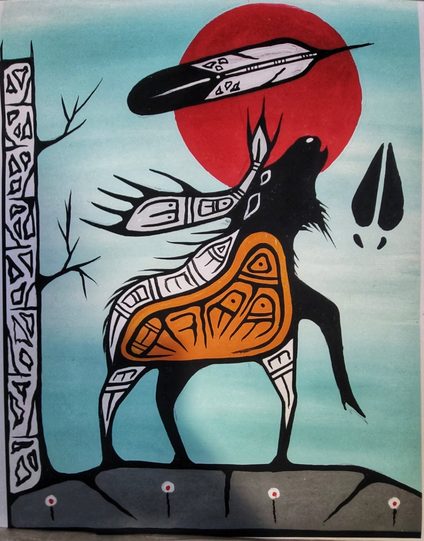
Please find the full Assessment Report attatched below.
By: Joseph Duncan and Aleksandra Spasevski.
In honour of Ringo Fiddler.
Ontario’s Far North recently received attention due to the $60 billion chromite mining potential. The massive mining project is known as the Ring of Fire. Both provincial and federal leaders have identified this mining opportunity as a multigenerational opportunity that can create both economic and societal benefits for communities (Chetkiewicz & Lintner, 2014).
Repercussions of mining developments generally have a significant impact on the economy, environment, society and Indigenous nations' natural habitat impacting their survival. Unfavorable repercussions of surface and subsurface mining incorporate waste material, environmental permanent devastations, and human rights violations under the Canadian Charter of Rights, United Nations Declaration of Indigenous People for First Nations communities. This can be comparable to the Nishnawbe Aski Nation (NAN) (Keeling & Sandlos, 2015). The potential economic contributions can significantly benefit both current and future generations.
History of the Nishnawbe Aski Nation Territory
Established in 1983, the Nishnawbe Aski Nation governance represents Forty-nine First Nations communities with a population of 45,000 in Northern Ontario (Nishnawbe Aski Nation, n.d.; Nishnawbe Aski Nation & Together Design Lab, 2018). This encompasses the James Bay Treaty 9. Signed in 1905 with Canada and Province of Ontario, Treaty 9 was established on the agreement to full sovereignty and autonomy involving hunting and trapping rights as well as education and economic stability on reserves.
In 1977, the Nishnawbe Aski Nation publicly declared their rights and principles for the people and the land. Indigenous and First Nations communities accepted a promise of happiness and prosperity however, the Crown haven’t fulfilled promises on the Treaty (Nishnawbe Aski Nation, n.d.; Nishnawbe Aski Nation & Together Design Lab, 2018).
"These rights include:
- The right to receive compensation for our exploited natural resources.
- The right to receive compensation for the destruction and abrogation of our hunting, fishing, and gathering rights.
- The right to renegotiate our Treaty as understood by our people, land and resources.
- The right to approach other world nations to further the aims of the Cree and Ojibway Nations of Treaty No. 9.”
(Nishnawbe Aski Nation, n.d.)
Recently, Northern Ontario’s First Nations leaders have placed a moratorium on the Ring of Fire mining development. Similar to the Mining Act, the Forestry Act and the Far North Act- Bill 191, the Ring of Fire mining development can eliminate Native rights without proper consultation. This is due to the minimal effort made by leaders and decision makers to properly consult with members of the Nishnawbe Aski Nation.
As a result, the Ring of Fire consultation process has been extended to ensure that communities within the Ring of Fire region are properly and meaningfully consulted (CBC News, 2021).
The Goals of this assessment are:
- Explore current understandings in how mining developments impact Indigenous communities.
- Highlight Nishnawbe Aski Nation’s Indigenous peoples' traditional knowledge and perspective on how their land rights are impacted by the Ring of Fire development.
- Highlight Nishnawbe Aski Nation’s Indigenous peoples' traditional knowledge and perspective on environmental and ecological damage on the Ring of Fire.
- Outline Nishnawbe Aski Nation’s Indigenous peoples’ recommendations for the Ring of Fire development.
Conclusion
As a result of the survey and interview data collected, participants expressed high concern about the impacts that the Ring of Fire can potentially have on the environment and their Indigenous ways of living. Due to climate change, shifts in migration and changes to ecosystems are already being seen by the participants within this assessment. Additionally, construction of infrastructure is seen altering hunting patterns and altering wildlife patterns. Further influences from the Ring of Fire can exacerbate these impacts and further influence Indigenous ways of knowing. Additionally, many participants outlined that the Ring of Fire has benefits. This mainly relates to the economic contributions and the increase in potential jobs for community members.
An important reflection that came out of this assessment is that decision makers and leaders must create better processes for meaningful consultations. Currently, participants in this assessment outline that they have not been informed or consulted on this topic. Moreover, many have described that regardless of the consultation process, their experiences and feedback would not impact the progress of the project and that decision makers will do what they feel is necessary without consideration for Indigenous communities.
As described previously, meaningful consultations don’t necessarily restrict a project's progress. Indigenous consultations can enhance benefits and ensure that there are mitigation efforts in place to support communities (Chong, 2014; Keeling & Sandlos, 2015). It is recommended for decision makers who are working on the Ring of Fire to meaningfully consult the NAN community in order to enhance the project and mitigate both environmental and societal impacts.

Image Credits: Paintings by Ringo Fiddler.
In light of Ringo Fiddler's passing, the researchers of this report would like to honour his memory by showcasing his artwork throughout this report. With Ringo's permission, all images in this report are based off of the artwork created by Ringo Fiddler. Miigwetch Ringo.
Please find the full Assessment Report attached.
| Attachment | Size |
|---|---|
| 16.49 MB |
